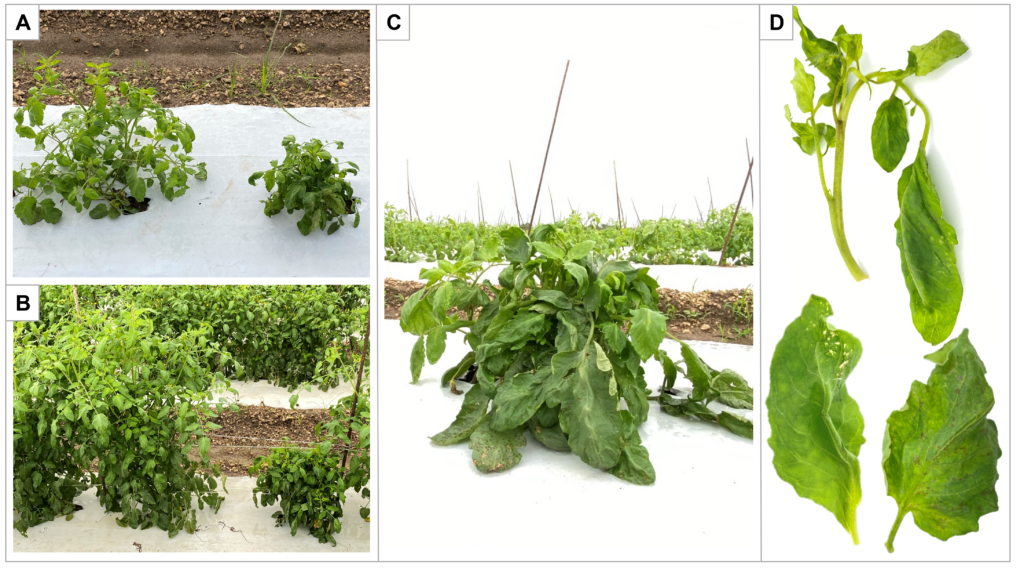By Ozgur Batuman and Salih Yilmaz
Ilarviruses can infect both herbaceous and woody plants and are known to be transmitted by pollen and seed with varying efficiency. Thrips have been associated as vectors of ilarviruses since they create wounds during feeding that can serve as entry points for virus particles carried in or on infected pollen.
Tobacco streak virus (TSV) was the first ilarvirus discovered in tomatoes and is globally distributed. Later, a few TSV-like tomato-infecting ilarvirus species, such as tomato necrotic spot virus and tomato necrotic streak virus (TomNSV), were found in California and Florida, respectively. Although TomNSV was found at relatively low incidences, the similarity of the virus fruit symptoms with those produced by orthotospoviruses (e.g., tomato chlorotic spot virus) already established in South Florida suggests that ilarviruses may be emerging as economically important plant viruses of tomatoes in different geographical areas. Therefore, they require extra attention.
SYMPTOMS AND SURVEYS
In 2020, tomato plants in Miami-Dade County displaying stem abnormality symptoms, leaf and midvein malformation, and downward leaf curling were collected. High throughput sequence analysis of three tomato samples revealed the presence of a virus closely related to the Ilarvirus genus. Upon comparing with known ilarviruses, including TomNSV, a newly emerged ilarvirus in Florida, researchers discovered that the identified virus was a distinct species of ilarvirus that had not been previously detected in either tomato plants or the state of Florida.
Partial sequences of the putative ilarvirus were found to be 69%, 59% and 75% similar to the RNA1 segment of spinach latent virus, RNA2 segment of Tulare apple mosaic virus and RNA3 segment of lilac ring mottle virus genome sequences, respectively. Based on this low sequence homology with known ilarviruses, researchers hypothesized that this virus could be a putative new member of the ilarvirus genus. They later confirmed the presence of this putative virus back in the original tomato samples using molecular assays.
In 2021 surveys conducted in Miami-Dade County, symptoms of downward leaf curling, dwarfing, loss of vigor, virus-like necrosis in new shoots, petioles and stems, and malformation of leaf and midvein were observed again in several tomato plants (Figure 1). A total of 12 tomato samples displaying these virus-like symptoms were collected from tomato fields. The presence of the novel ilarvirus was verified in nine of these samples. TomNSV was present in the remaining three samples.

In addition, researchers used the new virus in inoculation experiments on tomato plants and tobacco plants in the greenhouse. Fourteen days after inoculation, the tomato plants showed mild symptoms of malformed leaves, while the tobacco plants showed local lesions. These results indicate that the new ilarvirus persisted in tomato fields in 2020–21 and that it can infect tomatoes and potentially other solanaceous crops in the area.
It is important to note that although a putative new ilarvirus species in tomato plants in Miami-Dade County has been confirmed, further research is needed to understand its biology and any potential threat to the tomato industry in Florida. However, based on its similarity to TomNSV and low disease incidences in the field, researchers still cautiously believe that this putative new virus will not immediately threaten tomatoes in Florida.
GROWER RECOMMENDATIONS
Despite this, it is recommended that tomato growers be aware of the emergence of this virus and potentially other new viruses in their fields and take necessary precautions to prevent their spread. This includes implementing strict sanitation measures, such as avoiding using infected transplants and removing plant debris after harvest.
Additionally, growers should regularly monitor their crops for any signs of virus-like symptoms. Take appropriate actions if such symptoms are detected. This includes removing infected plants or implementing integrated pest management strategies to control the vectors responsible for transmitting the viruses. By staying vigilant and proactive in managing these emerging viruses, tomato growers can help protect their crops and ensure sustainable production for years to come.
If growers see unusual symptoms or suspect they may have a new virus-like disease, they should immediately contact their local Extension office for assistance. Growers can submit samples to their local University of Florida Institute of Food and Agricultural Sciences (UF/IFAS) Plant Diagnostic Lab or to the Florida Department of Agriculture and Consumer Services (FDACS) Division of Plant Industry (DPI). The FDACS DPI helpline number is 352-395-4600. For assistance with virus testing, contact your county Extension agent or Ozgur Batuman (obatuman@ufl.edu) at the UF/IFAS Southwest Florida Research and Education Center (SWFREC).
Ozgur Batuman is an assistant professor, and Salih Yilmaz is a graduate student, both at the UF/IFAS SWFREC in Immokalee.









